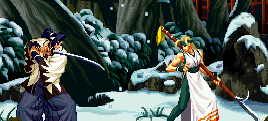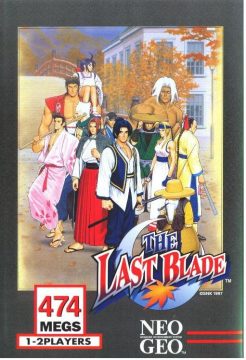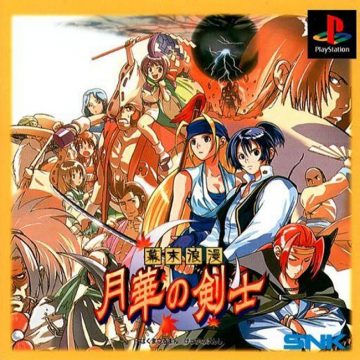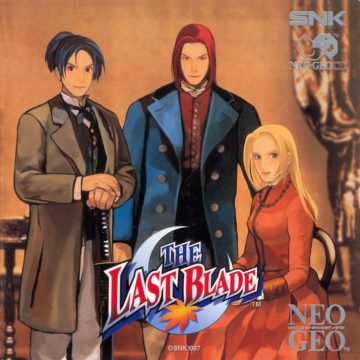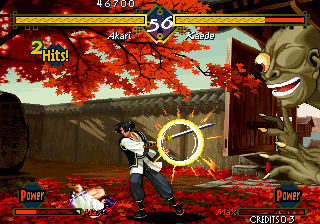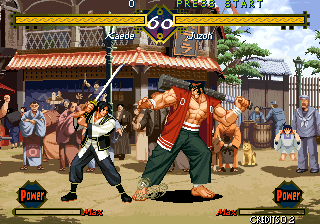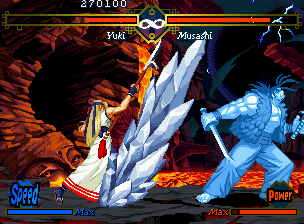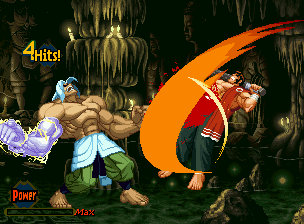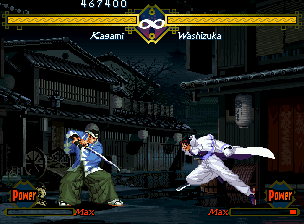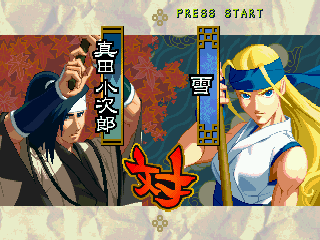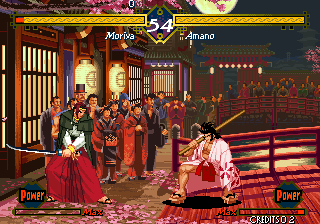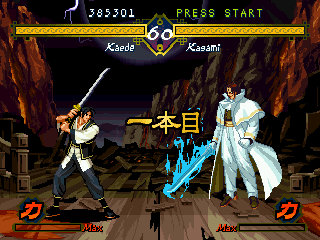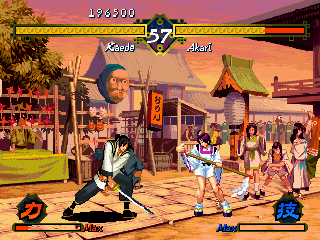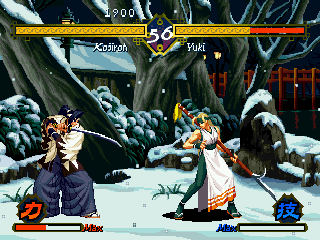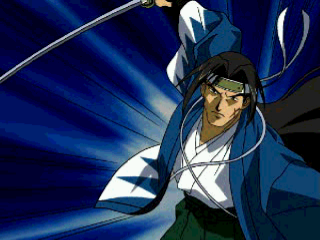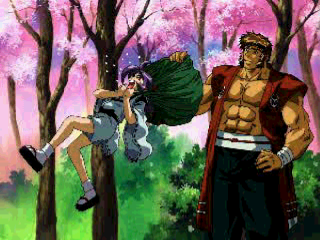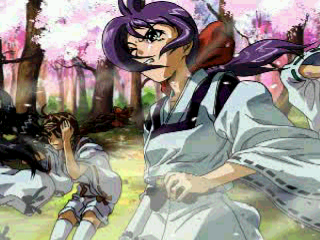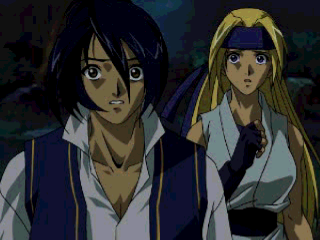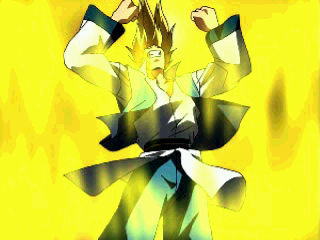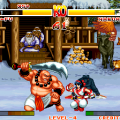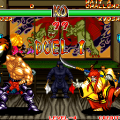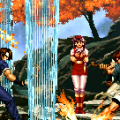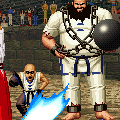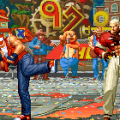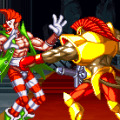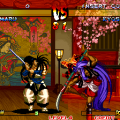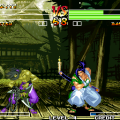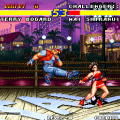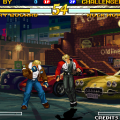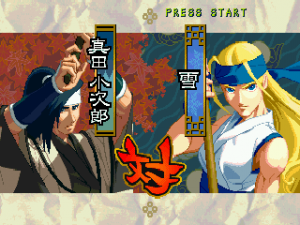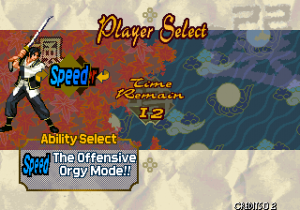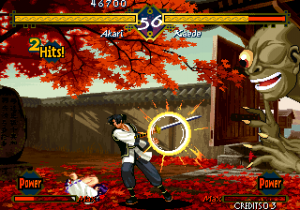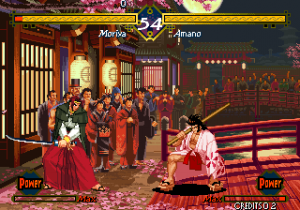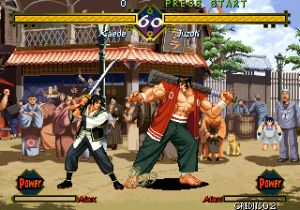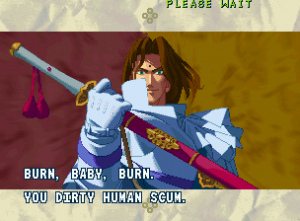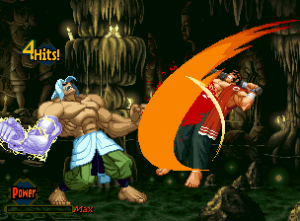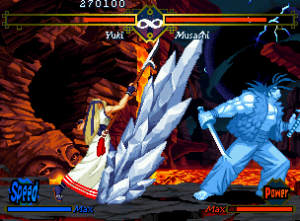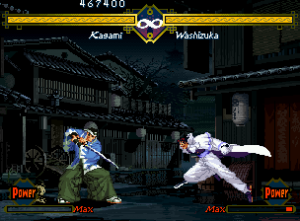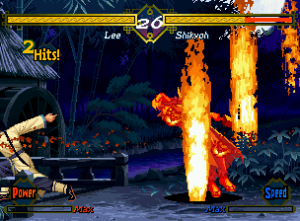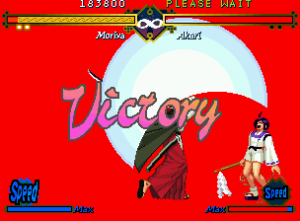- Last Blade, The
- Last Blade 2, The
Bakumatsu Roman: Gekka no Kenshi (“Moonlight Swordsmen”), also known as The Last Blade everywhere outside of Japan (except in Korea, where it’s called The Last Soldier), was initially overlooked compared to SNK’s fighting game franchises. Never quite garnering the mass popularity of The King of Fighters or Samurai Shodown, The Last Blade nevertheless gained a substantial cult following in the years after its release. Perhaps it was the combined factors that it was released on a ridiculously expensive console and wasn’t pushed into arcades in the same frequency that Samurai Shodown was, or maybe it was they were released when 2D fighting games were faltering in popularity. Whatever it was, it was an injustice, because the series is quite possibly SNKs finest endeavor.
Rather than being set between the Azuchi-Momoyama era (mid 1500s – early 1600s) and late Edo period (early 1600s – early 1800s) like most samurai fighting games, when the samurai were at their prime, The Last Blade takes place during the solemn Bakumatsu era at the end of the 19th century. Bakumatsu means End of the Bakufu Period, and as its name implies, it was the sometimes tragically viewed era when ancient Japanese culture and tradition were being discarded in favor of the Western lifestyle. The sword was replaced with the rifle, the kimono with the tuxedo. The samurai, who were the very essence of honor and discipline, weren’t even allowed to carry their swords into towns, and many were exiled from civilization, forced to earn a living as bounty hunters and hired assassins.
The somber setting and fairly intriguing characters gives The Last Blade a very distinct feel. While it seems similar to Samurai Shodown at a first glance, it’s almost nothing like SNK’s first weapon fighting series, from both an aesthetic and physical standpoint. However, a few of the characters are similar to characters in Nobuhiro Watsuki’s Rurouni Kenshin manga/anime – which makes sense, considering they both take place in the Bakumatsu era.
The first thing one notices about The Last Blade is how beautiful it is. It was like nothing SNK had made before. The sprites are probably the best looking ones ever seen on Neo Geo, comparable only to Garou: Mark of the Wolves. They’re detailed, lush, vibrant, and the animation is silky smooth. The characters are far more realistic and mature looking than the somewhat disproportionate, overly colorful Samurai Shodown characters, and the backgrounds have an insane level of detail.
The presentation of the game works perfectly. It’s dark, solemn, and carries an aura of twilight. You can really feel that an era is coming to an end. For instance, one stage is set in a traditional Japanese village, but the influence of the West already has begun creeping down the mountainside as telephone poles snake their way through the streets. These settings are inhabited by believable characters with their very own unique flavor. The game is simply dripping with style. Every sword stroke is performed with the utmost grace, fluidity, and exaggerated romanticism. It’s like art in motion, too good to be real, and yet more realistic than most other attempts at this genre. While some of the cover artwork was drawn by regular SNK artist Shinkiro, much of the rest of the art was done by Aki Senno, also known as TONKO, who later provided illustrations for Garou: Mark of the Wolves.
To match the somber tone of the game is a melancholy, synthed orchestral soundtrack. Where most other games of this genre use traditional Japanese music, this game reflects the Western influence of the visual design and follows European compositions instead. Not every battle is fought to music. Some battles are tastefully left to the ambiance of the setting. In Moriya’s bamboo forest stage, a shrill wind howls past the leaves as a waterwheel creeks in the background. In Washizuka’s stage, a dog barks off in the distance as some other creature rummages through trash in some unseen alley. The lack of music in some battles really makes the tension build up. It sounds scratchy coming through the Neo Geo AES/MVS synth, but its beauty really shines on the arranged CD soundtrack.
Even with such a beautiful presentation, the star of the show is the fighting engine. Like everything else in the game, it works beautifully. Because it’s a weapons-based fighting game, one would assume it plays something like Samurai Shodown, but it doesn’t. Not in the slightest. In fact, it doesn’t really play like any other 2D fighting game. There are two attack buttons, a kick button, and a repel button. Blocking is still done traditionally, by holding the joystick backwards. The repel is far more effective than the block, though, as it parries the enemy’s attack and creates an opening for your own. But this requires true mastery to time and wield correctly.
The Last Blade also focuses greatly on long chain combos. The buffer time makes doing combos a wonderful task for the experienced, as you can pretty much punch in the entire button string for a combo you know before you even get the second or third attack out and it’ll flow through without a hitch. Almost every character has a great combo string, and you can pretty much pick any character in the roster you think looks cool and be a great player with them, because it’s probably one of the most balanced fighting games ever.
Another aspect is the Sword Gauge. After selecting a character, you can choose from two different fighting styles; Power or Speed. Somewhat like the Slash and Bust system from Samurai Shodown III, the Power and Speed styles greatly change how a character works. With Power as your style, your character is very strong and can use a special super desperation move, but their potential for chain combos is very limited, usually losing pace after 3 or 4 hits. With Speed, your character is able to pull off 8, 9, 10 hit combos with very little effort, and they can also use their gauge to go into a custom combo mode similar to the X-Ism style from Street Fighter Alpha 3, but the strength of their attacks is toned down considerably.
There’s no doubt that The Last Blade is an excellent game. However, it’s been surpassed by its sequel, so it mostly remains forgotten. The only real reason to play this is for any of the specific backgrounds or music found only in this game (or if you want to play as Kaede before his powers give him blonde hair).
There are several different versions of The Last Blade. The Arcade and Neo Geo versions were, of course, virtually the same. The Neo Geo CD version contained a fully orchestrated arranged soundtrack. This soundtrack is absolutely amazing, and is one of the best orchestral soundtracks ever. However, as per usual with Neo Geo CD games, there’s some hefty loading times, and the music reloads after every round, meaning you’ll hardly ever hear much of it. The PlayStation version was more or less the same as the Neo Geo CD version, but with a (rather unimpressive) anime intro and the added feature of playing as Kojiroh Sanada (the real Kojiroh Sanada, not his sister), who’s actually just a palette swap of Washizuka. For the most part, the port is okay – there are some load screens (with some cute four panel comics), and while the action usually runs at a decent pace, there are some spots of slowdown. However, Yuki’s stage is almost impossible to play, because the added snow effects apparently cause the whole game to run in slow motion.
Early in 2006, SNK released a compilation of both The Last Blade games on PlayStation 2. These are pretty much ports of the Neo Geo CD versions, with added online play. Unfortunately, there’s still some slowdown, and the quality of the sound effects is pretty low. The Last Blade also appeared on the Wii Virtual Console, and the PlayStation port is available for download on the Japanese PSN.
